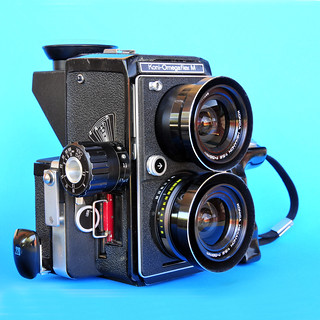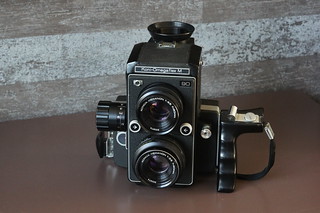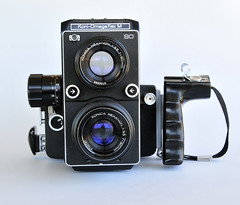Koni-Omegaflex M
The Koni-Omegaflex M is a medium format based TLR press camera system with exchangeable lens board, finders and film magazines.
Film
The camera shoots 6×7 cm negatives on 120 film or 220 film. There are 10 exposures with 120 film, while 220 film yields 20 exposures. Like the rest of the Koni-Omega series type cameras, the film is loaded onto the same two part film magazines, and uses a pull push knob for film advance built-into the magazine. The back has a reminder slot for film emulsion box tabs.
Lens
Each lens board includes a lens pair and a leaf shutter made by Seiko. Aperture and shutter speeds are adjusted on the lens. The shutter speed range from B, 1 to 1/500th of a second. There are f/5.6 58mm, f/3.5 90mm, f/3.5 135mm, and f/4.5 180mm lens boards. Each lens has a minimum aperture of f/22 and has a built-in lens hood or the taking lens. Mounting each lens changes the parallax view within the finder. The lenses can be changed mid-roll with the use of a dark slide. Flash sync can use both bulbs and electronic flash with a MX selector. It uses a standard PC sync connector on each lens board.
Finder
The finder is primarily designed for eye level viewing instead of waist level common with most TLR. There is a flip open hood on the back of the camera that reveals a ground glass. Viewing in this manner is similar to a large format camera with the image upside down. This can be changed to a prism or magnifier. With the prism, images are right side up and can be used for waist level viewing.

|
| Koni-Omegaflex M with Hexanon 58mm f/5.8 lens board and reflex angle viewfinder, image by Dirk HR Spennemann (Image rights) |
See here for the serial numbers which allow to date the production of the unit.
System

|
| image by René Maly (Image rights) |
Lens
- 58mm Hexanon f/5.6 (wide) 8 element, 4 group. series 7
- 90mm Hexanon f/3.5 (normal) 4 element, 3 group. series 6
- 135mm Hexanon f/3.5 6 element, 5 group. series 8
- 180mm Hexanon f/4.5 5 element, 4 group. series 8
Finder
- Folding hood
- Eye level with 3x magnifier
- Reflex with 2.8x magnifier
Film Magazine
- 120 film
- 220 film
Bibliography
- Lewis, Gordon, ed. The History of the Japanese Camera. Rochester, N.Y.: George Eastman House, International Museum of Photography & Film, 1991. ISBN 0-935398-17-1 (paper), 0-935398-16-3 (hard). P. 125.
- McKeown, James M. and Joan C. McKeown's Price Guide to Antique and Classic Cameras, 12th Edition, 2005-2006. USA, Centennial Photo Service, 2004. ISBN 0-931838-40-1 (hardcover). ISBN 0-931838-41-X (softcover). P. 539.
- Sugiyama, Kōichi (杉山浩一); Naoi, Hiroaki (直井浩明); Bullock, John R. The Collector's Guide to Japanese Cameras. 国産カメラ図鑑 (Kokusan kamera zukan). Tokyo: Asahi Sonorama, 1985. ISBN 4-257-03187-5. Item 2139.
Links
In English:
- Koni-Omegaflex M in Peter Lanczak's site about the Koni-Omega (also in German and French)
- Koni-Omegaflex M instruction manual at http://www.butkus.org
In French:
- Koni Omegaflex M and comparison with Rapid Omega 100 on Dirapon website
